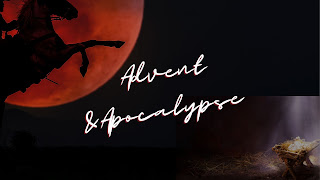Advent and Apocalypse - Emily Woodard
This year, as Christmas decorations went up and traditional carols entered worship services at church, the usual Advent readings have–for me–been juxtaposed with studies in the book of Revelation. (Maybe this is true for many ARP women who are participating in the annual study.) The result has been a providential push to think more about both the first and the second coming of Jesus Christ.
Historically, the return of Christ has been a focus of the Advent season, as many of the carol lyrics attest. For example, read through “Joy to the World” and ponder which ‘coming’ Isaac Watts may have been referring to (1). Or there’s “In the Bleak Midwinter” which, among the lines that highlight a stable setting, includes “heaven and earth shall flee away when he comes to reign,” alluding to Revelation 6:14. Despite the history of this double focus of Advent, personally and practically I’ve usually experienced the season more in the way Hannah Anderson labels the popular approach to it, “as a kind of ‘soft opening’ for Christmas.” (Heaven and Nature Sing, 1). Many modern celebrations of Advent center around just counting down the days to Christmas.
While my ‘new’ December train of thought–comparing and contrasting Jesus’s two appearings–is not original to me, it has been meaningful this year to connect Advent phrases like “the bleak midwinter” and the “half-gone” night (“Lo, How a Rose E’er Blooming”) with scenes from our own period of redemptive history such those described in Revelation 6: war, famine, and pestilence. During both periods leading up to the parousia of Christ, waiting necessarily characterizes the people of God. In the centuries immediately before the birth of Christ, darkness (Isa. 9:2) and silence reigned. The Davidic tree had been cut down to the stump (Isa. 11:1). Even faithful and devout Jews seem to have lost hope (e.g., Luke 1:18). And yet, “because of the tender mercy of our God [the sunrise visited] from on high to give light to those who sit in darkness and in the shadow of death…” (Luke 1:78-79). Those who were waiting saw the salvation of God (Luke 2:25-32). The words of the prophets were fulfilled (e.g., Matt. 1:22-23) as the seed of the woman, the descendant of Abraham, the prophet greater than Moses, Isaiah’s suffering servant, and Zechariah’s Branch was born to Mary and Joseph in Bethlehem.
The four horsemen of the apocalypse rarely make it to Christmas cards or the calendar of Advent readings–understandably, for the scenes of Revelation 6 are grim. Instead of “Peace on Earth, Goodwill to men,” peace is taken from the earth (v.4), and there is war, bloodshed, famine, and plague. Martyred saints are crying out for vindication in the final judgment of God. Again, the setting is dark, and the people of God are waiting, amidst conflict, pestilence, and death. But as the book of Revelation progresses, pictures of wrath and judgment are overshadowed by the description of the new heavens and earth, the wedding feast of the Lamb, and the dwelling of God with His people. And in the reader, a longing for the second coming of Christ continues to build so that by the end, when “He who testifies to these things says, “Surely I am coming soon,” we exclaim with John “Amen. Come, Lord Jesus!” (Rev. 22:20).
Revelation reminds us that there is day worth yearning and waiting for.
Christmas assures us that we do not wait and hope in vain.
